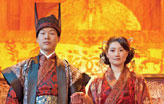Light of hope
Updated: 2011-04-08 11:36
By Liu Lu (China Daily European Weekly)
 |
|
Beijing palace lanterns are a fine art but the tradition is being lost because of lack of demand. Cao Xinjia / for China Daily |
Craftsman fights to save traditional palace lanterns
Fifty five-year old Zhai Yuliang gently strokes the delicate carvings on a rosewood Beijing palace lantern as its crimson paint glistens under the light. A round glass panel has been inlaid into the center of the six-sided lantern. A lifelike traditional Chinese watercolor painting of a cuckoo singing on the twig of a blossom peach tree is meticulously drawn onto the glass. This sophisticated lantern is handmade by Zhai and it took him almost two weeks to complete.
As a third generation Beijing palace lantern craftsmen and one of the few well-known lantern masters in China, Zhai's superb craftsmanship never lacks admirers.
But even so, in the past two decades he has failed to recruit new apprentices, which makes him constantly worry about the future of this special lantern-making tradition.
Zhai says although the Beijing palace lantern has been included in the national protection list of intangible cultural heritage since 2006, he still worries that his craft is a dying art.
"All the workers in my workshop are about 50 and no youngster wants to learn lantern-making skills today," Zhai says with a deep sigh.
From design to completion, an artisan normally carries out 100 procedures, involving carpentry, weaving and painting, and spends at least eight days to make a palace lantern.
To grasp the skill, one needs to spend at least three years' practicing.
"One needs to endure lots of hardship to master the workmanship, so none of the parents today would like to send their only child to learn the skill," he says.
Unlike today's bleak situation, Zhai's lantern workshop, which is centuries old, experienced its hey-day 20 years ago.
"I remembered in the 1970s and 1980s, people, both young and old, would look for that oriental touch and they preferred to make use of the Beijing palace lanterns at their homes or offices," Zhai says nostalgically.
"But today this old shop only attracts old customers."
Originating from the Ming Dynasty (1368-1644), the Beijing palace lantern was once an illumination tool for the imperial courts, and gradually developed into a popular lighting fixture and decorative item for ordinary households.
Although based on an ordinary lantern, it is far more ornate, decorative and larger in size. It is also embedded with painted silk or glass panes around the six sides of its body.
Regarded as a traditional artistic decoration, people in the past often placed the lantern at the center of an interior setting to make the room look more luxurious and splendid.
The lantern is not only a home favorite but is also found at venues with traditional Chinese characteristics, such as theaters, teahouses and restaurants.
But China is modernizing and as the concept of beauty changes for some, the once popular lanterns have become more and more incompatible with the modern Chinese home.
Fewer younger people these days are decorating their houses with such lanterns.
The high price of the lantern is also making it less attractive to common families. According to Zhai, a medium-sized lantern normally costs about 5,000 yuan (539 euros), making it more like a luxury good.
He says the lantern's high price is partly the result of the complicated making processes involved, but most significantly, materials used to make the framework of the lanterns, such as redwood, ebony and rosewood, are very expensive.
"Rising timber prices have forced the price of lanterns to soar. It is also impossible to mass produce it because it is a handmade product," Zhai says.
He says shrinking market demand for palace lanterns is a major reason why he finds it difficult to find successors in the trade.
In the 1980s, Zhai's workshop maintained an average yearly turnover of 500,000 yuan, but in 2010 that figure fell to 200,000 yuan, forcing Zhai and his co-workers to desperately look for new business channels.
Culture experts are quick to offer suggestions.
Some advise Zhai to brand palace lanterns as high-end luxury goods, which specifically target upscale consumers.
"The high price of the lantern has already forced it to become a luxury product or a valuable piece of fine artwork, so manufacturers have to analyze their consumers in order to market their products to the specific groups of people," says He Shuzhong, founder of the Beijing Cultural Heritage Protection Center. "They need to find out who are really interested in this traditional art form.
"It is also a good idea to integrate modern elements into the design of the lantern so as to reach more younger shoppers.
"Palace lantern manufacturers can also seek partnerships with Chinese furniture producers because households that feature Chinese furniture are more suitable for hanging such lanterns."
He says as a prominent symbol of traditional Chinese culture, the Beijing palace lantern has enjoyed a sought-after reputation throughout Chinese history.
It is a history worth preserving, he says.
"The inheritance of intangible cultural heritage does not only require the efforts of the craftsmen or relative enterprises, but also needs more policy support and financial aid from the government," He says.
Like the Beijing palace lantern makers, many other intangible cultural heritage craftsmen are facing the challenge of falling demand for their goods and lack of successors.
But help is on the way.
In 2009, the Ministry of Culture and State Council designated 2,516 national intangible cultural heritage items and 1,488 heirs, or master craftsmen, of intangible cultural heritage items.
The Ministry of Culture has been allocating an annual allowance of 8,000 yuan to the masters of these traditional crafts.
Also, China's first intangible cultural heritage protection law will take effect on June 1 and is designed to better preserve the country's cultural legacies.
Zhai has been given help, too.
Since 2006, Zhai's lantern workshop has received financial aid from the Beijing Arts and Crafts Association.
The Ministry of Foreign Affairs has also started ordering lanterns from him as gifts for foreign diplomats, and many ambassadors in China have been buying lanterns directly from him as souvenirs when they leave Beijing for other missions.
Zhai says this recent good business fortune has boosted his confidence but he is still wary.
"Apart from my shop, there were two other well-known palace lantern shops in Shanghai and Guangzhou, but they all went bankrupt in the 1980s and 1990s one after another due to the same problems I've encountered today," he says.
But he says as long as there are people who like his lanterns, he will try his best to keep his shop open and pass down his lantern-making skills to the next generation.
"I want to make the Beijing palace lanterns into a more popular tourism souvenir, as many foreigners like our products," says Zhai.
"I also hope future generations can also admire the beautiful palace lanterns as we do today."
E-paper

Han me downs
Traditional 3,000-year-old clothes are making a comeback.
Reaching out
Fast growth fuels rise in super rich
Chinese tourists spend more
Specials

Big spenders
More mainland tourists are expected to spend money on overseas travel this year.

Rise in super rich
Report cites rising property prices, gdp as key drivers of increasing number of chinese millionaires.

Reaching out
Condom makers are stepping up their presence in smaller cities to boost sales
